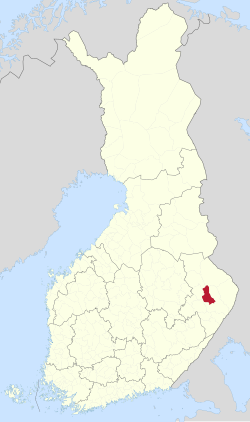Kontiolahti
Municipality in North Karelia, Finland From Wikipedia, the free encyclopedia
Municipality in North Karelia, Finland From Wikipedia, the free encyclopedia
Kontiolahti (Swedish: Kontiolax; literally meaning "bear bay") is a municipality in Finland. It is located in the North Karelia region, about 20 kilometres (12 mi) north of Joensuu. The municipality has a population of 15,071 (31 August 2024)[2] and covers an area of 1,029.82 square kilometres (397.62 sq mi) of which 230.1 km2 (88.8 sq mi) is water.[1] The population density is 18.84 inhabitants per square kilometre (48.8/sq mi). Neighbouring municipalities are Joensuu, Juuka, Lieksa, Liperi and Polvijärvi. The municipality is unilingually Finnish.
Kontiolahti
Kontiolax | |
|---|---|
Municipality | |
| Kontiolahden kunta Kontiolax kommun | |
 Kontiolahti Church in July 2012 | |
 Location of Kontiolahti in Finland | |
| Coordinates: 62°46′N 029°51′E | |
| Country | |
| Region | North Karelia |
| Sub-region | Joensuu |
| Charter | 1873 |
| Government | |
| • Municipal manager | Jere Penttilä |
| Area (2018-01-01)[1] | |
| • Total | 1,029.82 km2 (397.62 sq mi) |
| • Land | 799.82 km2 (308.81 sq mi) |
| • Water | 230.1 km2 (88.8 sq mi) |
| • Rank | 101st largest in Finland |
| Population (2024-08-31)[2] | |
| • Total | 15,071 |
| • Rank | 74th largest in Finland |
| • Density | 18.84/km2 (48.8/sq mi) |
| Population by native language | |
| • Finnish | 97.6% (official) |
| • Swedish | 0.1% |
| • Others | 2.3% |
| Population by age | |
| • 0 to 14 | 21.1% |
| • 15 to 64 | 61% |
| • 65 or older | 17.9% |
| Time zone | UTC+02:00 (EET) |
| • Summer (DST) | UTC+03:00 (EEST) |
| Website | www.kontiolahti.fi |
The coat of arms of the municipality is a canting arms; the log driving pike pole, which the bear carries in the picture, refers to the importance of forestry in the region's economy. The coat of arms was designed by Aarno Liuksiala and approved by the Kontiolahti Municipal Council at its meeting on December 8, 1952. The coat of arms was approved for use by the Ministry of the Interior on February 27, 1953.[4][5]
Kontiolahti hosted the Biathlon World Championships in 1990, 1999 and 2015.[6]
Kontiolahti originally belonged to the parish of Liperi. It became an independent municipality in 1873. The flood nuisance of Lake Höytiäinen and the desire for water abandonment inspired residents to try to build a canal to lower the water level, but the dam broke uncontrollably in 1859, and the landscape changed dramatically.[7] After World War II, the Ruskeala's migrants were stationed in Kontiolahti.

Kontiolahti has 183 lakes, and water bodies cover 22.3 percent (230 km2) of the municipality's surface area. The largest of them are Lake Höytiäinen, Lake Kangasvesi and Lake Herajärvi.[8] There are 11 Natura sites in all or part of Kontiolahti: Teerisaari-Sisuslahti, Soikkeli Forest, Pöllönvaara-Kruununkangas, Paihola Forest, Kolvananuuro and surrounding areas, Koli National Park, Jouhteninen, Huurunlampi-Sammakkolampi-Huurunrinne and Huuhkajanvaara.[9]
Joensuu Region's Public Transport (Joensuun seudun joukkoliikenne; JOJO) is responsible for local and school traffic in the Kontiolahti area.[11] Kontiolahti also has a railway station,[12] which, however, no longer has passenger traffic. Highway 6 passes through the municipality.[13][10]
Municipal library services are provided by the Kontiolahti Library, the Lehmo Library, and Runo-Antti, the bookmobile of Kontiolahti and Eno.[14][15][16][17]
In the 1980s, Kontiolahti's parish dishes were named "shoemaker's roast" (suutarinpaisti) and stockfish soup.[18]
Seamless Wikipedia browsing. On steroids.
Every time you click a link to Wikipedia, Wiktionary or Wikiquote in your browser's search results, it will show the modern Wikiwand interface.
Wikiwand extension is a five stars, simple, with minimum permission required to keep your browsing private, safe and transparent.